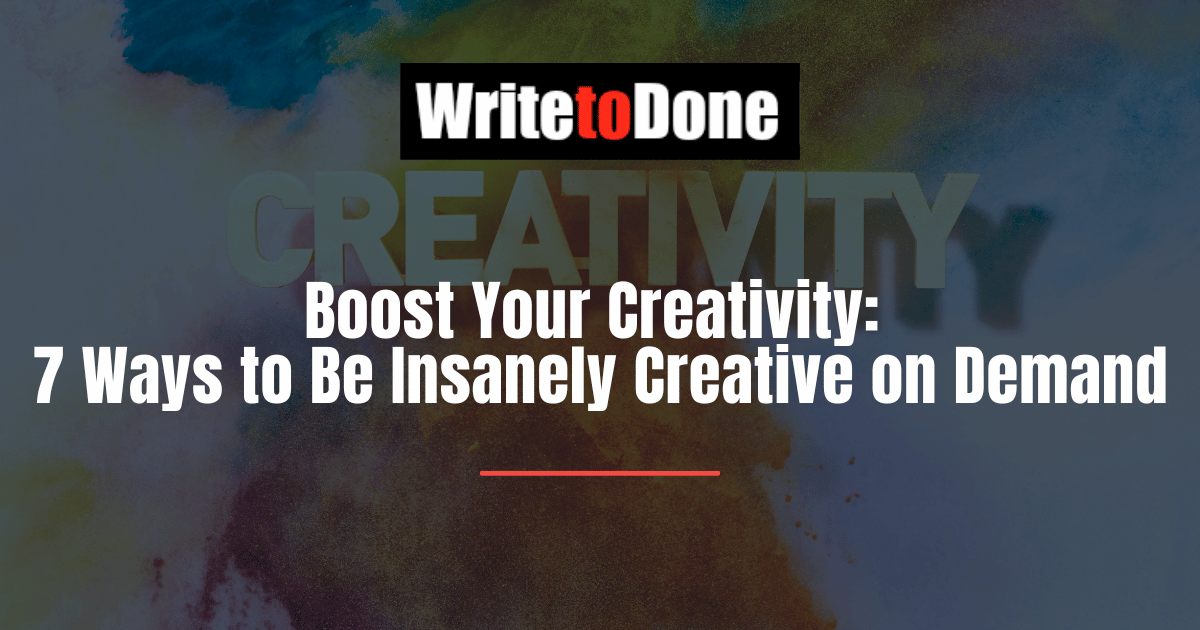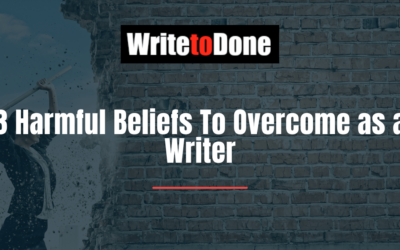Wouldn’t you love to be consistently creative?
It’s great when our friends and family support us and think we can do anything as long as it involves words, and a keyboard or pen.
The truth, though, is that we all get stuck from time to time.
Creativity is fickle.
Getting past the stuck places can be hard, but it doesn’t have to be.
Here are seven techniques I use to boost my creativity and get out of a creative funk. I’m sure they’ll help you too!
After the first one, they’re in no particular order except for number seven, which is best used as a last resort.
Method 1: Keep Your Brain Full
The first step in generating an idea is to stuff your brain, and keep it full.
Feed your brain with everything: random stuff that has no real purpose or goal, as well as input related to your current project.
You can find input in a wide variety of places including books, blogs, images and music. Movies, television and videos are other great sources of material to feed your brain.
The most important part of this step is focusing on what you’re putting into your brain, not what you’re hoping to get from it. The output often bears very little relationship to the input.
When you stuff your brain as full as possible of really good stuff, you’ll get good stuff back out without even trying.
Mary Jaksch highlights the importance of focusing on input rather than output in Refuel Your Creativity.
Method 2: Keep a Wheel Book
The term “wheel book” comes from Henriette Anne Klauser’s book Write it Down, Make It Happen. “Wheel book” feels much more adventurous than “ubiquitous capture device,” which comes from David Allen’s Getting Things Done.
Whatever you call it, you need a place where you jot things down, whether it’s a notebook, a voice recorder or a smartphone.
There are four rules for wheel books:
- Choose a wheel book that you love and will use.
- Keep your wheel book with you at all times.
- Capture everything in your wheel book.
- Review your wheel book regularly.
Of course “capture everything” doesn’t mean literally everything.
A good method is to write down ideas, questions, reminders and things that make you think, smile, laugh or frown. Fortunately for me, I use an electronic wheel book, because a lot of things make me go “hunh?!” and I’d need a new notebook every Monday.
Look at your notes at least once a week. Look through them when you’re stuck and need a spark of inspiration.
Even a small spark will do. You can fan even the tiniest spark into a creative flame, if it is a good spark.
Method 3: Create More Downtime
During a rare lunch with a friend yesterday, I had a mini-epiphany.
I feel better after an actual lunch break away from my desk, than when I “take a lunch break” on the couch but work the entire time.
I’m amazed by this downtime thing and I’m going to try it again someday soon.
Time away from your creative work—to rest your body and your mind—matters. Pushing to exhaustion only leads to poor writing and poor health.
I’m committing to real downtime every day. I encourage you to do the same.
How should you spend your downtime?
Resting and relaxing are great downtime pursuits. You might enjoy solving puzzles or making things. Perhaps you would enjoy getting out and spending time in nature. If you’re stuck for ideas, here are 21 Unexpected Places to Find Your Muse. Why not use a couple of ideas this week?
Method 4: Be Still
This method is about stilling your mind.
Fortunately for me, it doesn’t always require a still body.
If you meditate or would enjoy meditation, that’s an excellent way of being still, but there are other ways.
My favorite ways to still my mind are writing and photography. I’m convinced I could take photos of ham sandwiches for half an hour at a stretch, or write half a book without pause, and feel as refreshed as if I’d slept eight hours.
Whether your stillness involves sitting, walking or activity, do something that makes your brain go “aaaaah.”
Not the “stick-out-your-tongue-so-the-doctor-can-look-down-your-throat” aaaaah, but the “I-just-sat-down-in-a-hot-tub-with-a-glass-of-wine-and-a-plate-of-chocolate” aaaaah.
If your brain loves sitting meditations, sit. If it loves rock climbing and hang gliding, climb and fly.
Your brain needs time to work in the background when it’s not expected to do much else. That’s why we get ideas in the shower.
So be still.
Method 5: Add More Nonsense to Your Life
You probably know that as a writer, you need an imagination and a few other things.
While a modicum of talent is handy, time, training and practice are essential.
Another ingredient also trumps talent: Nonsense.
Writing is serious work. Even writing funny words is serious work.
Nonsense lets your brain relax and take a little bath in silliness to wash away the stress and be refreshed.
When you find yourself stuck or stalled, take a moment to indulge in a little nonsense. If your office happens to not have talking guinea pigs (as mine does), spend some time on social media, or call up your favorite silly person and talk about nothing for five minutes.
Method 6: Relax
Tension creates more creative holes and ruts than anything else, and we need to find a way to periodically release this tension.
When I grow frustrated with my writing, I take a moment to listen to my body and assess my environment.
I roll my shoulders and neck a few times to get the stiffness out, sit up straight on my chair and pull it forward so I don’t slouch. I also shut down my email and turn on some music.
I call this relaxing in place, as opposed to stretching out on the couch with my feet up and a book in my hands.
Relaxing in place means simply taking a moment to make the necessary adjustments in your environment and your body, to let the tension flow away.
This is not a substitute for downtime and crashing on the couch with a book.
That kind of relaxation isn’t a substitute for on-the-fly relaxation in place, either.
You need both to keep your creative brain functioning at its best.
Method 7: Be Creative Anyway
Eleanor Roosevelt spoke my favorite words about creative ruts. “You must do the thing you think you cannot do.”
When I feel that I don’t have a single creative idea in my head and probably never will again, and that work just isn’t happening for me today, I try the techniques I’ve listed above.
Most days one of these techniques, or five or six, will ease me back into creative flow.
If they don’t, I take the nuclear option.
Here’s how you do it.
Start writing.
If you’re working on something, review the previous section and start from there. If you’ve finished your previous project, copy the last two paragraphs into a new document, review them and delete all but the first sentence of that passage. Start writing as if you are writing these paragraphs from the start.
Start with a goal of writing 100 words. When you reach 99 words, and you will, stretch your goal to 200 words.
Keep pushing yourself forward until you feel you can keep going without pushing. If you reach your average daily word count, that’s great. If not, that’s great, too. The point of the exercise is to write anyway, and not let your brain lock up.
This technique always works.
I can count on one hand, without my thumb or one of my fingers, how many times, in 25 years as a professional writer, I’ve used this technique and not found my creativity click into place.
Grab Your New Toolbox and Start Creating
You now have a set of techniques to boost your creativity and get past the stuck places in your writing and your creative life.
Some of the ideas are simple, while others may feel like a stretch. The last one probably feels more like a medieval torture rack than a “stretch.”
Whether a particular technique seems too simple to work, or too much trouble to try, give all of them a try anyway.
I use these tools because they work. And that’s why I’m recommending them to you.
Which of these tools are you the most excited about? Let me know in the comments.

















